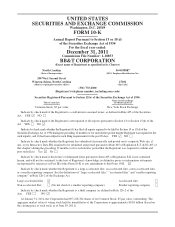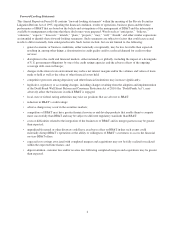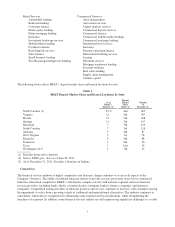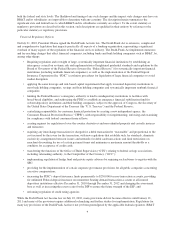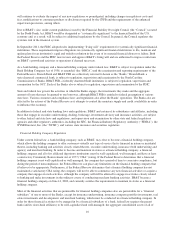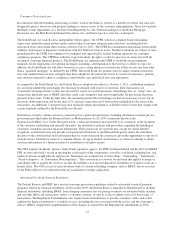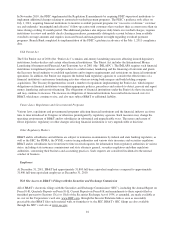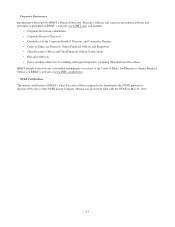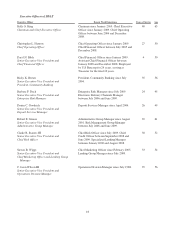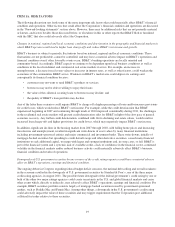BB&T 2011 Annual Report Download - page 9
Download and view the complete annual report
Please find page 9 of the 2011 BB&T annual report below. You can navigate through the pages in the report by either clicking on the pages listed below, or by using the keyword search tool below to find specific information within the annual report.both the federal and state levels. The likelihood and timing of any such changes and the impact such changes may have on
BB&T and its subsidiaries are impossible to determine with any certainty. The description herein summarizes the
significant state and federal laws to which BB&T and its subsidiaries currently are subject. To the extent statutory or
regulatory provisions are described in this section, such descriptions are qualified in their entirety by reference to the
particular statutory or regulatory provisions.
Financial Regulatory Reform
On July 21, 2010, President Obama signed the Dodd-Frank Act into law. The Dodd-Frank Act is extensive, complicated
and comprehensive legislation that impacts practically all aspects of a banking organization, representing a significant
overhaul of many aspects of the regulation of the financial services industry. The Dodd-Frank Act implements numerous
and far-reaching changes that affect financial companies, including banks and bank holding companies such as BB&T, by,
among other things:
• Requiring regulation and oversight of large, systemically important financial institutions by establishing an
interagency council on systemic risk and implementation of heightened prudential standards and regulation by the
Board of Governors of the Federal Reserve System (the “Federal Reserve”) for systemically important financial
institutions (including nonbank financial companies), as well as the implementation of the Federal Deposit
Insurance Corporation (the “FDIC”) resolution procedures for liquidation of large financial companies to avoid
market disruption;
• applying the same leverage and risk-based capital requirements that apply to insured depository institutions to
most bank holding companies, savings and loan holding companies and systemically important nonbank financial
companies;
• limiting the Federal Reserve’s emergency authority to lend to nondepository institutions to facilities with
broad-based eligibility, and authorizing the FDIC to establish an emergency financial stabilization fund for
solvent depository institutions and their holding companies, subject to the approval of Congress, the Secretary of
the United States Department of the Treasury (the “U.S. Treasury”) and the Federal Reserve;
• centralizing responsibility for consumer financial protection by creating a new independent agency, the
Consumer Financial Protection Bureau (“CFPB”), with responsibility for implementing, enforcing and examining
for compliance with federal consumer financial laws;
• creating regimes for regulation of over-the-counter derivatives and non-admitted property and casualty insurers
and reinsurers;
• requiring any interchange transaction fee charged for a debit transaction be “reasonable” and proportional to the
cost incurred by the issuer for the transaction, with new regulations that establish such fee standards, eliminate
exclusivity arrangements between issuers and networks for debit card transactions and limit restrictions on
merchant discounting for use of certain payment forms and minimum or maximum amount thresholds as a
condition for acceptance of credit cards;
• transferring the functions of the Office of Thrift Supervision (“OTS”) relating to federal savings associations,
including rulemaking authority, to the Comptroller of the Currency (“OCC”);
• implementing regulation of hedge fund and private equity advisers by requiring such advisers to register with the
SEC;
• providing for the implementation of certain corporate governance provisions for all public companies concerning
executive compensation;
• increasing the FDIC’s deposit insurance limits permanently to $250,000 for non-transaction accounts, providing
for unlimited Federal deposit insurance on noninterest bearing demand transaction accounts at all insured
depository institutions effective December 31, 2010 through December 31, 2012 and changing the assessment
base as well as increasing the reserve ratio for the DIF to ensure the future strength of the DIF; and
• reforming regulation of credit rating agencies.
While the Dodd-Frank Act became law on July 22, 2010, many provisions did not become effective until January 21,
2011 and many of the provisions require additional rulemaking and further studies for implementation. Regulations for
many key provisions of the Dodd-Frank Act have not yet been promulgated by the applicable federal regulators. BB&T
9

